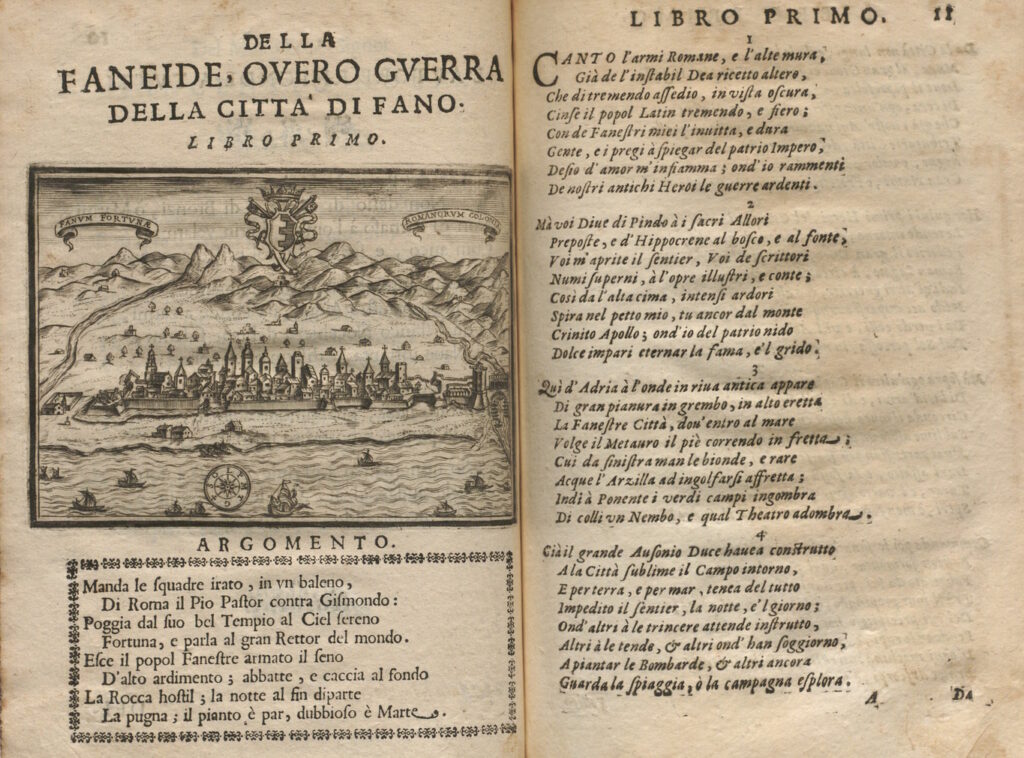Glossary
Topical poetry

Other languages
- Dutch: gelegenheidspoëzie, gelegenheidsgedicht
- French: poésie de circonstance
- German: Gelegenheitsgedicht
- Italian: poemi in ottava rima, guerre in ottava rima
- Polish: poezja okolicznościowa
- Spanish, specific forms: justas poéticas, carteles poéticos, vejamen
Material form
Printed book, Single-sheet printSubject
Music and performative literature, News and current affairsDescription
Topical or occasional poetry was written in response to an event in the family (birth, marriage, death) or public sphere (battle, commemoration), or on the occasion of a poetry contest (e.g. of rhetoricians, or the Spanish justas poéticas). Usually the poet was somehow involved in this event. Poems on the occasion of a marriage (epithalamium) have a long (Greek and Latin) tradition. In the early modern period, such poems appeared in print to be distributed among the wedding guests (evidently at weddings of well-to-do couples in particular). A Spanish example of topical poetry were the carteles poéticos, broadsheets containing a poem with decoration. Especially popular during the 17th century, they were composed and designed for religious or civic festivals and hung in public places during the festivities. The vejamen was a satirical poem composed for the occasion of a doctoral degree. Printed in quarto, they usually counted some 8 to 50 pages.
A popular genre in the Italian peninsula was a report of news in verse, with an almost exclusive focus on military news. News poems were usually performed and sold in the piazzas by itinerant street singers. The print genre originated in Northern Italy as early as the late 15th century, experienced its heyday in the 16th century during the period of the Italian wars (1494-1559), and virtually disappeared around halfway through the 17th century. It followed the well-known medieval tradition of the chivalric poem, together with that of the avvisi, most commonly adopting the scheme of the ottava rima (8 lines of 11 syllables). It commonly contained a list of casualties as an appendix, referred to as the non poetiche rassegne (non-poetical review), which was later adopted by some avvisi.
The news poem gave rise to other genres that blurred the lines between news and entertainment in the 17th century. Several pamphlets started to narrate battles in allegorical terms, referring for example to the ‘battle of the wasps’ or the ‘battle of the birds’.
News poems also appeared in Spain. These relaciones de sucesos (see News pamphlets) in verse, printed in quarto, were typically shorter than the more common relaciones de sucesos in prose. The latter targeted a more educated audience.
Related terms
Sources
W. Barner, Barockrhetorik: Untersuchungen zu ihren geschichtlichen Grundlagen (Tübingen: Niemeyer, 1970).
U. Bornemann, Anlehnung und Abgrenzung: Untersuchungen zur Rezeption der niederländischen Literatur in der deutschen Dichtungsreform des siebzehnten Jahrhunderts (Assen: Van Gorcum, 1976).
J. Bouman, Nederlandse gelegenheidsgedichten voor 1700 in de Koninklijke Bibliotheek te ‘s-Gravenhage; catalogus van gedrukte gedichten op gedenkwaardige gebeurtenissen in het leven van particuliere personen (Nieuwkoop: De Graaf, 1982).
R. Bussi et al., Guerre in ottava rima, 4 vols. (Modena: Panini, 1989).
Catálogo y biblioteca digital de Relaciones de sucesos, BIDISO (Biblioteca Digital Siglo de Oro), http://www.bidiso.es/CBDRS
N. Geerdink and A. Lassche, ‘Social and Economic Imperatives for the Production of Wedding Poetry in the Dutch Republic: A Data-Driven Analysis’, Quaerendo 50:1-2 (2020), 81-108. https://doi.org/10.1163/15700690-12341457.
S. González-Sarasa Hernáez, Tipología editorial del impreso antiguo español, thesis Universidad Complutense de Madrid (2013), 396-399 (‘Cartel poético’), 409- 414 (‘Justa poética’), 438-440 (‘Vejamen’). https://eprints.ucm.es/id/eprint/24020/
U. McIlvenna, ‘Ballads of Death and Disaster: The Role of Song in Early Modern News Transmission’, in: J. Spinks and C. Zika (eds.), Disaster, Death and the Emotions in the Shadow of the Apocalypse, 1400-1700 (London: Palgrave Macmillan, 2016), 275-294.
K. Lavéant and M. Walsby, ‘Celebrating, Interpreting, and Spreading News: Nicaise Ladam and Publishing Topical Poetry in the Southern Low Countries (1508-1522)’, Quaerendo 48:1 (2018), 17-38.
M. Meserve, ‘News from Negroponte. Politics, Popular Opinion and Information Exchange in the First Decade of the Italian Press’, Renaissance Quarterly 59:2 (2006), 440-480.
A. Nieuweboer, ‘Medeleven volgens voorschrift en verzen op bestelling. Achttiende-eeuwse gelegenheidsgedichten’, Literatuur 3 (1986), 15-22.
M. Petta, ‘War News in Early Modern Milan: The Birth and the Shaping of Printed News Pamphlets’ in: J. Raymond and N. Moxham (eds.), News Networks in Early Modern Europe (Leiden/Boston: Brill, 2016), 280-304.
A. Quondam et al. (eds.), Guerre in ottava rima (Ferrara-Modena: Istituto di Studi Rinascimentali – edizioni Panini, 1989), 4 vols.
M. Rospocher, ‘Songs of War. Historical and Literary Narratives of the «Horrendous Italian Wars» (1494-1559)’, in: M. Mondini and M. Rospocher (eds.), Narrating War: Early Modern and Contemporary Perspectives (Bologna: Il Mulino/Berlin: Duncker&Humblot, 2013), 63-78.
M.A. Schenkeveld-van der Dussen, ‘Poëzie als gebruiksartikel: gelegenheidsgedichten in de zeventiende eeuw’ in: M. Spies (ed.), Historische letterkunde. Facetten van vakbeoefening (Groningen: Wolters-Noordhoff, 1984), 75-92.
W. Segebrecht, Das Gelegenheitsgedicht: ein Beitrag zur Geschichte und Poetik der deutschen Lyrik (Stuttgart: Metzler, 1977).
R. Thomas, ‘Éphémères et rites nuptiaux. Les épithalames illustrés dans les Pays-Bas du xviie siècle’, in: O. Belin and F. Ferran (eds.), Les éphémères et l’événement (Paris: Éditions de la Maison des sciences de l’homme, 2018), 49-64. http://books.openedition.org/editionsmsh/11903
V. Tufte, The Poetry of Marriage: The Epithalamium in Europe and Its Development in England (Los Angeles: Tinnon-Brown, 1970).

